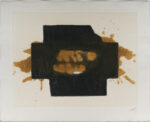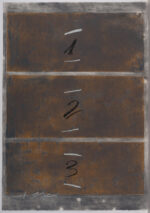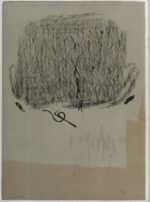Tàpies, Antoni
"BIOGRAPHY OF ANTONI TAPIES:
Barcelona, December 13, 1923 - February 6, 2012.
1. Family Context and Education
Antoni Tàpies, son of the lawyer Josep Tàpies and Maria Puig, grew up in a liberal environment influenced by Catalan political life. The tension between his father's anticlericalism and his mother's orthodox Catholicism led him to search for a new spirituality, which he found in Eastern philosophies, especially Zen Buddhism.
During his youth, a convalescence from consumption at the age of 18 marked his life. In the sanatorium of Puig d'Olena (1942-1943), he took refuge in literature (Ibsen, Nietzsche, Mann) and music, while copying works by Van Gogh and Picasso. He abandoned his law studies at the University of Barcelona in 1946 to devote himself fully to art, being largely self-taught.
2. Artistic beginnings and Dau al Set
In 1946 he established his first studio in Barcelona. Two years later, he founded the surrealist and Dadaist group Dau al Set, together with Joan Brossa, Modest Cuixart, Joan-Josep Tharrats, Joan Ponç, Arnau Puig and Eduard Cirlot. The group, active until 1956, was key in his early artistic stages.
3. Stylistic Evolution: From Surrealism to Informalism
Initially influenced by Surrealism, Tàpies soon became one of the major exponents of Informalism and material painting, using materials such as cardboard, paper and marble dust. He exhibited in the October Salons and events such as Cobalt 49 and the VII Salón de los Once in Madrid (1949).
In 1950 he represented Spain at the Venice Biennale, participating in several editions. That same year he traveled to Paris with a scholarship from the French Institute, and exhibited at the Carnegie International Competition in Pittsburgh. His first exhibition in the United States was organized in 1953 by the art dealer Martha Jackson in New York.
4. International Consolidation
In 1955 he founded the Taüll group with artists such as Cuixart, Aleu and Tharrats. Since the late 1950s, his work was exhibited internationally in cities such as New York, Paris, Berlin, Rome and Tokyo. In 1958 he received the Carnegie Prize and in 1960 he was awarded in Tokyo, consolidating his global projection.
5. Political Commitment and Activism
During the 1970s, his work acquired a strong political charge in defense of Catalan nationalism and in opposition to Franco's regime, incorporating symbols such as the four bars of the Catalan flag. He participated in protests such as the closing of the Sarrià convent in 1966 and the march to Montserrat in 1970.
6. Acknowledgements and Antoni Tàpies Foundation
Tàpies was recognized with numerous awards, such as the Prince of Asturias Award for the Arts (1990) and the Gold Medal of the Generalitat de Catalunya (1983). In 1990 he inaugurated the Fundació Antoni Tàpies in Barcelona, dedicated to promoting contemporary art and preserving his legacy.
7. Scenic and Theoretical Production
In addition to his pictorial works, Tàpies worked on scenographies, illustrations for books and posters. He published articles in media such as La Vanguardia and Avui, compiled in books such as La práctica del arte (1970) and Memoria personal (1977), where he defended a modern and committed art.
8. Last Years and Legacy
In 2007 he donated an original work to support the campaign against the closure of TV3 broadcasts in Valencia. His work has been exhibited in major modern art museums around the world, and remains a key reference in the history of contemporary art.
Showing 9 of 22 resultsOrderedby latest
-

Tapies – Ref 3043 S/T composicio 16
1.900,00 € -

Tàpies – Ref 244
3.200,00 € -

Tàpies – Ref 901 Tresse
3.400,00 € -

Tàpies – Ref. 2250 Fregoli
1.200,00 € -

Tàpies – Ref 2294 Nocturn matinal
2.800,00 € -

Tàpies – Ref 903 Triptic vertical
2.900,00 € -

Tàpies – ref 601 Voilé
2.900,00 € -

Tàpies – Ref 2549 Serie La LLum
1.800,00 € -

Tàpies – Ref. 1667
1.750,00 €
